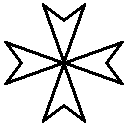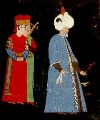A Delacorte Book
On Sale in the UK
On Sale in Germany
|
||||||||||
|
...was an extraordinary age — an age of sweeping social change, an age that spawned great art, great literature, and great conflict....
Michelangelo was finishing the Last Judgment (1541) in the Sistine Chapel, whose ceiling he had completed three decades earlier. The wall on which he created the masterpiece measured fifty-five by forty feet. Working by the light of a candle, he crafted a fresco dominated by the figure of Christ, a profound vision of Judgment Day that struck terror and awe into those who saw it. Jean de la Valette
was Grand Master of the ancient order
of the Knights of
Suleiman
was tenth and greatest Sultan of the Ottomans, presiding over the golden age
Dragut Raïs
was known as the Drawn Sword of Islam. Scourge of the Christian world, brilliant corsair and gifted navigator,
his fleets carried thousands
into slavery. He operated from Djerba, an island off the African coast that was home
to the Lotus Eaters
of Odysseus. The Ottoman historian Darius noted that
“of all the odd
turns of fate in those eventful years before the
great battle of Malta, none was more singular than Dragut’s presentiment of
his own death. 'I have felt the shadow of the wing of death in this island
[Malta],' he told his commanders. 'It is written that I, too, shall die in
the territory of the knights.' His intuition was oft repeated throughout the
Maltese islands, as indeed it was in every Christian corner of the Middle
Sea, where, predictably, the fervent wish was that the premonition would
come true sooner rather than later...” Paul III (1534-49). Reorganized the Inquisition, casting off the mantle of Torquemada and in its place unveiling the Holy Roman Inquisition, dedicated to the eradication of the Protestant plague unleashed by Martin Luther. Paul initiated the Council of Trent, which began profound reforms of a corrupt Church. Paul IV (1555-59). Surrounded the Jewish quarter in Rome with a wall, creating a ghetto: it was God’s wish, said the Holy Father, that servitude be imposed upon the Jews until they recognized the error of their faith. He published an index condemning and banning the works of hundreds of authors, including Rabelais and Machiavelli. In 1559 he assigned the artist Volterra the task of covering the nudity in Michelangelo’s Last Judgment, earning the unfortunate Volterra the enduring title of ‘the breeches maker.’ Pius IV (1559-65). ‘We have been informed that the destructive poison of heresy has wormed its way into the City and Island of Malta,” the pope wrote to Grand Master La Valette, “even among the members of the Order of Jerusalem [the Knights of St. John, defenders of the faith].’ Pius named an Inquisitor, who began an investigation of heresy among the Knights. The Order of St.
John of Jerusalem, known as the
Knights of St. John or the Knights of Malta: an ancient order of
hospitallers, created to provide aid to pilgrims
More to follow soon:
|




 Europe was a hodgepodge
of Christian kingdoms, duchies, republics, and principalities, all enmeshed
in an unending series of religious wars and political intrigues. In the
east the Ottoman sun was rising; the Sultan Suleiman’s armies even
reached the gates of Vienna. The Barbary states of Africa were ruled by
Suleiman’s allies — Moors, Berbers, and Arabs — while his galleys dominated
the Mediterranean. Elizabeth, the Virgin Queen, was
Protestant ruler of England (1558-1603); the Hapsburg Charles V was
Holy Roman Emperor and king of Spain, succeeded as king by his son,
Philip.
Europe was a hodgepodge
of Christian kingdoms, duchies, republics, and principalities, all enmeshed
in an unending series of religious wars and political intrigues. In the
east the Ottoman sun was rising; the Sultan Suleiman’s armies even
reached the gates of Vienna. The Barbary states of Africa were ruled by
Suleiman’s allies — Moors, Berbers, and Arabs — while his galleys dominated
the Mediterranean. Elizabeth, the Virgin Queen, was
Protestant ruler of England (1558-1603); the Hapsburg Charles V was
Holy Roman Emperor and king of Spain, succeeded as king by his son,
Philip.
 of a splendid empire. His subjects called him the Lawgiver; even his enemies called
him the Magnificent. He wrote poetry and his armies flowed like rivers over
the earth. He resided in Constantinople, the glorious city straddling Asia
and Europe. Suleiman tolerated (and taxed) Christians and Jews, whose
scriptures were based on divine revelations and therefore
sacred.
of a splendid empire. His subjects called him the Lawgiver; even his enemies called
him the Magnificent. He wrote poetry and his armies flowed like rivers over
the earth. He resided in Constantinople, the glorious city straddling Asia
and Europe. Suleiman tolerated (and taxed) Christians and Jews, whose
scriptures were based on divine revelations and therefore
sacred. making their way to the Holy Land during the Crusades. The knights
soon became warrior-monks, their ranks filled by the sons of the noblest
families of Europe. Driven from Jerusalem by Saladin, they made their home
on the island of Rhodes, where for two hundred years they
flourished as a seafaring order of corsairs in the service of Christ. The
young sultan Suleiman drove the knights from Rhodes in 1522. He spared their
lives in exchange for their promise to leave his minions in peace. It
was a promise they would not keep.
making their way to the Holy Land during the Crusades. The knights
soon became warrior-monks, their ranks filled by the sons of the noblest
families of Europe. Driven from Jerusalem by Saladin, they made their home
on the island of Rhodes, where for two hundred years they
flourished as a seafaring order of corsairs in the service of Christ. The
young sultan Suleiman drove the knights from Rhodes in 1522. He spared their
lives in exchange for their promise to leave his minions in peace. It
was a promise they would not keep.
